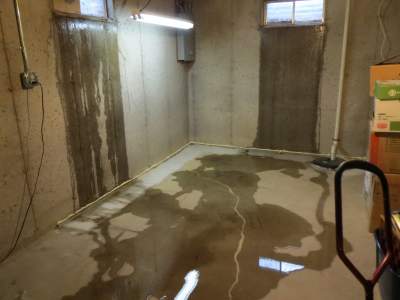A building, which has a basement, has a great chance to face the problem of seepage of water or penetration of water through the wall of the basement especially at the time of heavy precipitation. This water from seepage stay at the floor line of a basement and if not controlled this condition can cause severe damage to the interior wall of the basement and the contents of the basement. This type of water seepage can get into the basement through the crack of the foundation walls and can develop over time if not it handled properly.
Porous building materials, such as concrete block, are capable of percolation and seepage of water through the building material itself and into the interior portion of the structure. Another source of moisture arises from capillary action and water vapor.
Facts and Ways of Water Intrusion into the Basement [3]:
Water can enter a basement in several ways. The conventional basement consists of three elements. Such as
- A foundation wall.
- A footer on which the wall rests.
- A floor slab.
Underground water and Groundwater is the main source of water which will enter a basement.
If the water table rises above the level of the basement floor water can enter the basement through the side wall.

So what is the solution to this problem?????????????? The answer is basement waterproofing. Below we have discussed briefly the basement waterproofing, methods, which methods are efficient etc.
What is Basement Waterproofing?
Basement waterproofing means the technique and the materials to prevent seepage of water into the basement or the penetration of water into the basement of a house or structure. This waterproofing is for an underground room of a structure.
Method of Basement Waterproofing
There have many ways of solving the problem of seepage of water but all the way is not truly efficient because of cost and difficulty of installation.
Some Method and the fact about those methods [2]:
- Trying to seal the crack after the formation of a crack of a foundation wall. It can be done at inside or outside. It is not only costly but also ineffective.
- Moisture resistant flashings or coatings can be a solution but Moisture-resistant flashings or coatings tend to fracture and tear due to building expansion, settling, and careless installation.
- By setting a plywood board against the foundation wall before the pouring of concrete slab water can be drained from the interior of the basement. Then the board is removed while the concrete is still "green' and not completely set. But this procedure has some disadvantages:
- it causes damage to the edge of the concrete floor;
- it results in additional labor costs,
- it may cause the concrete floor to shift.
So an efficient method is highly desirable for waterproofing solution. Two methods, which are considered as efficient, are described below.
Efficient Methods of Basement Waterproofing
Method 1[2]
Apparatus: Drainage Control Apparatus
Part of the Apparatus: Vertical leg, Horizontal leg, Embossments, Longitudinal spacer slip, Drainpipe.
Methodology: A drainage control apparatus has been used in this method. A vertical leg of this apparatus has been set up to the vertical side wall of the basement and a horizontal leg has been set up to the top of the foundation footing. The vertical leg consists of an embossment at the bottom end of the vertical leg. The vertical leg also consists of a longitudinal spacer lip at the upper end of the vertical leg. Both the embossment and the spacer lip touch vertical side wall of the basement to maintain a gap between the vertical leg and the vertical side wall. The horizontal leg consists of channels to flow water into a drain pipe. For the corner of the basement, the apparatus is named as corner drainage control apparatus but the setting of the apparatus is same. After that concrete is poured to fulfill the slab and then the vertical portion of the apparatus has been cut off to level the apparatus with slab end. This invention is quite easy to install and it is also advantageous because it can drain water from the interior of the basement.
Method 2[1]
A sump system in geometry is rectangular. It has two side elements with apertures to exchange the groundwater while blocking debris. In another side element, an adjustable inlet had been provided to connect other elements of a basement waterproofing system to the sump liner. After that in the sump liner, a base configured can be used to provide a built-in stand for the sump pump. The pump stand contains a lip including notches to allow the fallen of debris and collection in a trough around the periphery of the base. The base further provides an underside cavity which accommodates an obstruction in the floor of the sum hole. A removable lid used to facilitate the access of the interior of the sump liner and also contains a breakaway feature to accommodate discharge piping. The sump liner can be oriented into the sump hole to protect the basement foundation from the adverse effect of erosion.
References
- Andras, S. Basement sump system, and method. U.S. Patent 8973324B2 filed January 24, 2013, and issued March 10, 2015.
- Geske, D. R. Apparatus, and method for waterproofing basements. U.S. Patent 4869032A filed September 25, 1987, and issued September 26, 1989.
- Read, R. R. Basement Waterproofing. U.S. Patent 5845456A filed December 14, 1990, and issued December 8, 1998.
- DiFiore, D. Basement waterproofing system. U.S. Patent 4136500A filed March 30, 1978, and issued January 30, 1979.

